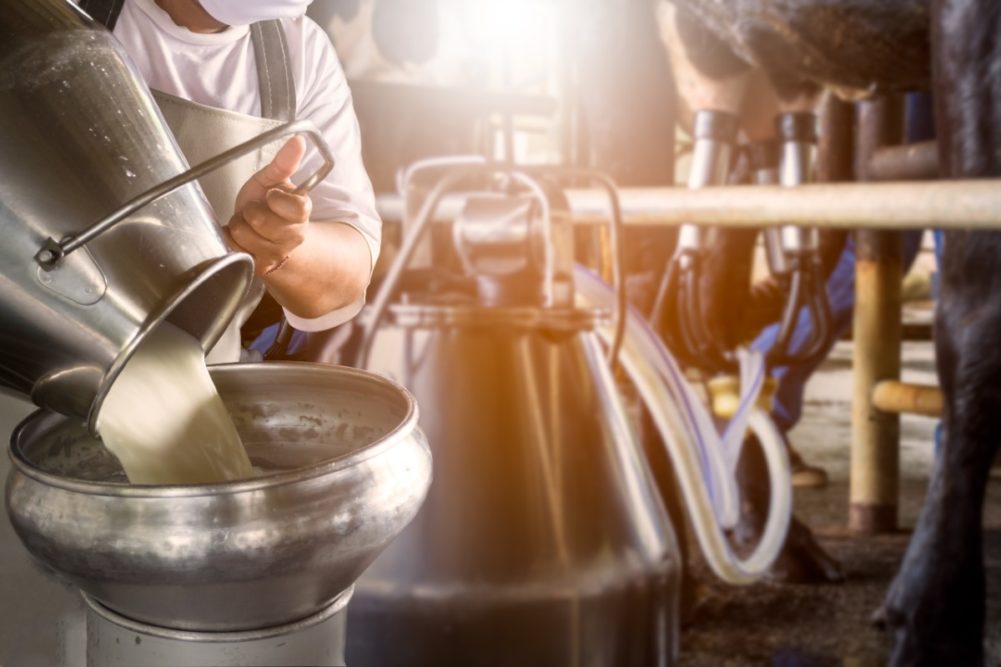Though the growth ahead may move slowly, the US dairy industry should expect to see some minor gains in 2022.
Carolyn Liebrand, an agricultural economist with the United States Department of Agriculture’s marketing service, detailed during the Dairy Outlook session at the USDA’s 98th Agricultural Outlook Forum how the lingering effects of the global pandemic will carry over into this year, but US milk production is forecasted to slightly improve.
While growth in milk production slowed worldwide among leading exporting countries in the second half of 2021 and contracted in the fourth quarter, Liebrand said during the webinar that US milk production is expected to reach 227.2 billion pounds in 2022 – just 0.4% growth.
A boost in dairy product wholesale prices in 2022 is anticipated to lift the all-milk price (which reflects the prices paid to producers for milk with the level of fat and other milk components in it as it comes off the farm) to $23.55 per cwt, which is $4.86 above 2021.
Meanwhile, the estimate price for milk used to make cheese and whey is expected to average $3.22 per cwt higher in 2022, at $20.30 per cwt of Class III, with 3.5% butterfat.
Additionally, relatively high butter and nonfat dry milk prices mean a $6.21 per cwt increase in the average price for milk used to make those dairy products in 2022. Although the forecast Class IV price for milk with 3.5 percent butterfat, $22.30 per cwt, actually is higher than the Class III price for 2022, the Class IV price is expected to move down as the year progresses.
“While we projected US total milk production to have very slow growth at 0.4%, the content of components and that milk should be a little bit richer,” Liebrand said.
For 2022, butter prices are forecasted to average $2.39 per pound, 66 cents higher than 2021. Prices for butter are expected to decline gradually both in the US and internationally.
With the world supply for nonfat dry milk dampened, US prices on that front are expected to continue to go up in the first quarter of 2022 and persist through the middle of the year.
The price of cheddar cheese is predicted to increase in 2022, averaging 22 cents above 2021, at $1.90 per pound.
High whey prices are forecasted to continue in 2022, too, with an expected average of 70.5 cents per pound, which is 13 cents more than 2021.
Overall, Liebrand echoed the sentiment shared by US Secretary of Agriculture Tom Vilsack earlier at the USDA’s conference, when he projected a bright and positive future for US agriculture.
“I believe that is the case also for dairy, while there will be complexities lingering from the last two years in the US economy,” she said.
Global supply chains have proven to be one massive difficulty of late for US dairy. William Loux, senior director of global trade analysis, US Dairy Export Council, said ocean freight is crucial for US dairy exports.
“Congestion, delays, ghost bookings and higher costs, you name it, all hurt the US dairy industry –processors and farmers and pretty much everybody's bottom line,” Loux said. “Pretty much everybody's bottom line except for probably the carrier companies.”
While the US dairy industry moved a record $7.66 billion in exports in 2021, Loux said most of the growth came from Mexico, which isn’t reflective of the challenges that come with exporting from the country’s ports. And the other significant source of that growth came from China, a destination where most shipping vessels are always moving back and forth, making it easier for the US to get its exports there.
Loux said the supply chain and shipping challenges of 2021 actually still cost the US in major markets, through lost opportunities for more successful export sales.
“Europe and New Zealand had pretty poor (dairy) production years this past year, and the US should have taken advantage to increase market share, particularly in Southeast Asia and also Middle East and North Africa,” he said. “We really should have increased the market share more than we did.”
What’s more, Loux said the exports the US was able to move should have sold at higher price points, given the global supply chain problem. He said the USDEC estimated all of those factors combined cost the US dairy industry nearly $1.6 billion.
Even so, he projected a positive outlook for 2022 US dairy exports.
“I am still pretty bullish,” Loux said. “I have seen these headwinds and I still think the fact that the US dairy industry managed record exports despite the congestion at port is a really good sign of the commitment of US dairy exporters and farmers to these overseas markets to make sure that they have the product they need.”
He also said an opportunity exists for US dairy to step in and fill the gaps as Europe, New Zealand and Australia are experiencing declines in milk production.

